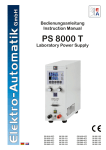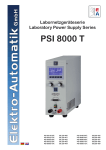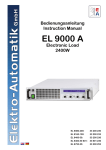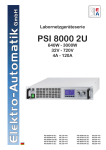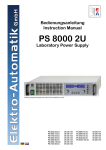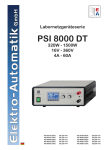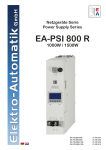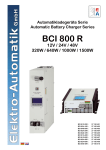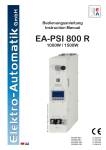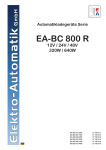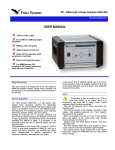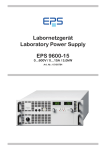Download Anleitung
Transcript
Labornetzgeräteserie PS 8000 T PS 8016-20T: PS 8032-10T: PS 8065-05T: PS 8032-30T: PS 8065-10T: 09 200 120 09 200 121 09 200 122 09 200 123 09 200 124 PS 8160-04T: PS 8080-40T: PS 8080-60T: PS 8360-10T: PS 8360-15T: 09 200 125 09 200 126 09 200 127 09 200 128 09 200 129 DE Allgemeines Impressum Bedienungsanleitung Labornetzgerät Serie PS 8000T Elektro-Automatik GmbH & Co. KG Helmholtzstrasse 31-33 41747 Viersen Germany Telefon: +(49) 02162 / 37850 Fax: +(49) 02162 / 16230 Web: www.elektroautomatik.de Mail: [email protected] Sicherheitshinweise •Das Gerät ist nur mit der angegebenen Netzspannung zu betreiben •Keine mechanischen Teile, insbesondere aus Metall, durch die Lüftungsschlitze in das Gerät einführen! •Die Verwendung von Flüssigkeiten aller Art in der Nähe des Gerätes ist zu vermeiden, diese könnten in das Gerät gelangen •Keine Spannungsquellen an den Ausgang des Gerätes anschließen, die die Nennspannung des Gerätes übersteigen können •Um eine Schnittstellenkarte in dem dafür vorgesehenen Einschub © Elektro-Automatik Nachdruck, Vervielfältigung oder auszugsweise, zweck-entfremdete Verwendung dieser Bedienungsanleitung sind verboten und können bei Nichtbeachtung rechtliche Schritte nach sich ziehen. Stand: Januar 2009 zu bestücken, müssen die einschlägigen ESD- Vorschriften beachtet werden. •Die Schnittstellenkarte darf nur im ausgeschalteten Zustand aus dem Einschub herausgenommen oder bestückt werden. Eine Öffnung des Gerätes ist nicht erforderlich. Inhaltsverzeichnis 1. Einleitung 4 2. Technische Daten 2.1 Bedien- und Anzeigeeinheit 2.2 Gerätespezifische Daten 4 4 5 3. Gerätebeschreibung 3.1 Frontansicht 3.2 Rückansicht 3.3 Lieferumfang 6 6 7 7 4. Allgemeines zum Gerät 4.1 Vorwort / Warnhinweis 4.2 Kühlung 4.3 Gerät öffnen 7 7 7 7 5. Installation 5.1 Sichtprüfung 5.2 Netzanschluss 5.3 Anschluss DC-Ausgang 5.4 Anschlussklemme Sense (Fernfühlung) 5.5 Slot für Erweiterungskarte 7 7 7 7 8 8 6. Bedienung 6.1 Die Anzeige 6.2 Tasten am Bedienfeld 6.3 Weitere Bedienelemente 6.4 Sollwerte einstellen 8 8 8 9 9 7. Verhalten bei ... 7.1 Einschalten mit dem Netzschalter 7.2 Ausschalten mit dem Netzschalter 7.3 Ein- oder Ausschalten mit der Taste Standby 7.4 Umschalten auf Fernsteuerung (Remote) 7.4 Überspannung 7.5 Übertemperatur 7.6 Spannungs-/Stromregelung 7.7 Fernfühlungsbetrieb 7.8 Netzüber-/Netzunterspannung 10 10 10 10 10 10 11 11 11 11 8. Geräte-Setup 11 9. Digitale Schnittstellenkarten 12 10. Analoge Schnittstelle 10.1 Allgemeines 10.2 Anwendungen 12 12 12 © 2009, Elektro-Automatik GmbH & Co. KG Irrtümer und Änderungen vorbehalten DE Über das Gerät 1. Einleitung Die Labornetzgeräte der Serie PS 8000T sind kompakte und robuste Geräte, die auf kleinem Raum eine Vielzahl von interessanten Möglichkeiten bieten. Über die gängigen Funktionen von Netzgeräten hinaus können 5 verschiedene Sollwertvorgabesätze eingestellt, gespeichert und bei Bedarf abgerufen werden. Weiterhin ist eine fest integrierte, analoge Schnittstelle, die die gängigen Spannungsbereiche 0...5V und 0...10V bedient, vorhanden. Diese ermöglicht zum Einen die Überwachung des Gerätes und zum Anderen die komplette Fernsteuerung. Mittels optionalen Schnittstellenkarten (CAN, RS232, USB oder IEEE/GPIB) können von einem PC aus nahezu alle Funktionen des Gerätes gesteuert und das Gerät werden. Die Integration in bestehende Systeme ist mittels der Schnittstellenkarte leicht möglich, die Konfiguration ist einfach und wird am Gerät erledigt, sofern überhaupt nötig. Die Labornetzgeräte können so z. B. über die analoge Schnittstelle im Verbund mit anderen Labornetzgeräten betrieben werden bzw. von einer SPS oder einem anderem Gerät mit analoger Schnittstelle gesteuert werden oder dieses steuern. Das Gerät ist mikroprozessorgesteuert und erlaubt eine genaue und schnelle Messung und Anzeige von Istwerten. Das Tower-Design ermöglicht platzsparende Konzeptionierung selbst von aufwendigen und leistungsfähigen Anwendungen, wie z. B. industrielle Prüfsysteme mit variablen Leistungen für die unterschiedlichsten Anwendungen oder zu Demonstrations- und Testzwecken im Entwicklungs- oder Ausbildungsbereich. Die Hauptfunktionen im Überblick: » Stellen von Strom und Spannung, jeweils 0...100% » Einstellbarer Überspannungsschutz 0...110% Unenn » Wechselbare Schnittstellenkarten (CAN, USB, RS232, IEEE/GPIB) » Analoge Schnittstelle für externe Ansteuerung und Messung mit 0...5V oder 0...10V (umschaltbar) für 0...100% » Leistungsklassen 320W, 640W, 1000W und 1500W » Temperaturgesteuerte Lüfterregelung » Zustandsanzeigen (OT, OVP, CC, CV) über LEDs » Energiesparmodus (Standby) » 5 speicherbare Sollwertsätze 2. Technische Daten 2.1Bedien- und Anzeigeeinheit Ausführung Anzeige: LED-Sieben-Segment-Anzeige mit vier Stellen plus Komma, LEDs Bedienelemente: 2 Drehimpulsgeber, 6 Tasten Anzeigeformate Die Nennwerte bestimmen den maximal einstellbaren Bereich. Ist- und Sollwerte werden für Spannung und Strom stets gleichzeitig dargestellt, der Sollwert für den Überspannungsschutz separat. Anzeige von Spannungswerten Auflösung: Genauigkeit: Formate: 4-stellig max. ±0,2% von Unenn 0.00V...16.00V 0.00V...32.00V 0.00V...65.00V 0.00V...80.00V 0.0V…160.0V 0.0V...360.0V Anzeige von Stromwerten Auflösung: Genauigkeit: Formate: 4-stellig max. ±0,2% von Inenn 0.000A…4.000A 0.000A...5.000A 0.00A...10.00A 0.00A...15.00A 0.00A...20.00A 0.00A...40.00A 0.00A...60.00A © 2006, Elektro-Automatik GmbH & Co. KG Irrtümer und Änderungen vorbehalten © 2009, Elektro-Automatik GmbH & Co. KG Irrtümer und Änderungen vorbehalten © 2009, Elektro-Automatik GmbH & Co. KG Irrtümer und Änderungen vorbehalten * Bezogen auf den Nennwert Netzeingang Eingangsspannung Frequenz Eingangsstrom max. Sicherung Leistungsfaktor Einschaltstrom Leistungsaufnahme Output off Leistungsaufnahme Standby Ausgang - Spannung Nennspannung Unenn Einstellbereich Stabilität Netzausregelung ±10% ?UE Stabilität bei 10…90% Last Restwelligkeit Genauigkeit* Auflösung der Anzeige Senseausregelung Überspannungsschutz (einstellbar) Ausgang - Strom Nennstrom Inenn Einstellbereich Stabilität Netzausregelung ±10% ?UE Stabilität bei 0…100% ?UA Restwelligkeit Genauigkeit* Auflösung der Anzeige Ausregelzeit 10….90% Last Ausgang - Leistung Nennleistung Pnenn Nennleistung < 150V UE Verschiedenes Betriebstemperatur Lagertemperatur Luftfeuchtigkeit rel. Abmessungen (BxHxT) Gewicht Sicherheit EMV-Normen Überspannungskategorie Schutzklasse Artikelnummer 90…264V 45…65HZ 4A T 4A > 0.99 < 25A 12W 7W 2V 0V…Unenn < 0.02% < 0.05% < 40mVpp = 0.2% 10mV max. 2.0V 0…5.2V 0…10A 0A…Inenn < 0.05% < 0.15% < 50mApp = 0.2% 10mA < 2ms 20W 20W 90…264V 45…65HZ 4A T 4A > 0.99 < 25A 12W 7W 16V 0V…Unenn < 0.02% < 0.05% < 40mVpp = 0.2% 10mV max. 2.0V 0…17.6V 0…20A 0A…Inenn < 0.05% < 0.15% < 50mApp = 0.2% 10mA < 2ms 20W 20W 25W 25W 0…5A 0A…Inenn < 0.05% < 0.15% < 50mApp = 0.2% 1mA < 2ms 65V 0V…Unenn < 0.02% < 0.05% < 40mVpp = 0.2% 10mV max. 2.0V 0…71.5V 90…264V 45…65HZ 4A T 4A > 0.99 < 25A 12W 7W PS 8065-05 T 640W 640W 0…20A 0A…Inenn < 0.05% < 0.15% < 50mApp = 0.2% 10mA < 2ms 2V 0V…Unenn < 0.02% < 0.05% < 40mVpp = 0.2% 10mV max. 2.0V 0….5.2V 90…264V 45…65HZ 8A T 8A > 0.99 < 25A 12W 7W PS 8032-20 T 640W 640W 0…10A 0A…Inenn < 0.05% < 0.15% < 50mApp = 0.2% 10mA < 2ms 65V 0V…Unenn < 0.02% < 0.05% < 40mVpp = 0.2% 10mV max. 2.0V 0…5.2V 90…264V 45…65HZ 8A T 8A > 0.99 < 25A 12W 7W PS 8065-10 T 640W 640W 0…4A 0A…Inenn < 0.05% < 0.15% < 50mVpp = 0.2% 1mA < 2ms 160V 0V…Unenn < 0.02% < 0.05% < 40mVpp = 0.2% 100mV max. 2.0V 0…176V 90…264V 45…65HZ 8A T 8A > 0.99 < 25A 12W 7W PS 8160-04 T 1000W 1000W 0…40A 0A…Inenn < 0.05% < 0.15% < 100mApp = 0.2% 10mA < 2ms 1500W 1000W 0…60A 0A…Inenn < 0.05% < 0.15% < 100mApp = 0.2% 10mA < 2ms 80V 0V…Unenn < 0.02% < 0.05% < 70mVpp = 0.2% 10mV max. 2.0V 0…88V T 16A > 0.99 < 25A 1W 11W T 16A > 0.99 < 25A 1W 11W 80V 0V…Unenn < 0.02% < 0.05% < 70mVpp = 0.2% 10mV max. 2.0V 0…88V 90…264V 45…65HZ PS 8080-60 T 90…264V 45…65HZ PS 8080-40 T 1000W 1000W 0…10A 0A…Inenn < 0.05% < 0.15% < 15mApp = 0.2% 10mA < 2ms 60V 0V…Unenn < 0.02% < 0.05% < 100mVpp = 0.2% 100mV max. 2.0V 0…96V T 16A > 0.99 < 25A 1W 11W 90…264V 45…65HZ PS 8360-10 T 1500W 1000W 0…15A 0A…Inenn < 0.05% < 0.15% < 15mApp = 0.2% 10mA < 2ms 60V 0V…Unenn < 0.02% < 0.05% < 100mVpp = 0.2% 100mV max. 2.0V 0…96V T 16A > 0.99 < 25A 1W 11W 90…264V 45…65HZ PS 8360-15 T 0….40°C 0….40°C 0….40°C 0….40°C 0….40°C 0….40°C 0….40°C 0….40°C 0….40°C 0….40°C -20….70°C -20….70°C -20….70°C -20….70°C -20….70°C -20….70°C -20….70°C -20….70°C -20….70°C -20….70°C < 80% < 80% < 80% < 80% < 80% < 80% < 80% < 80% < 80% < 80% 90x240x280mm 90x240x280mm 90x240x280mm 90x240x280mm 90x240x280mm 90x240x280mm 90x240x95mm 90x240x95mm 90x240x95mm 90x240x95mm 5kg 5kg 5kg 5kg 5kg 5kg 9kg 9,kg 9kg 9,kg EN 60950 EN 6126, EN 55022 Klasse B Klasse II KlasseI 09200120 09200121 09200122 0920012 09200124 09200125 09200126 09200127 09200128 09200129 PS 8032-10 T PS 8016-20 T Über das Gerät DE 2.2Gerätespezifische Daten DE Über das Gerät 3. Gerätebeschreibung 3.1 Frontansicht Beschreibung der Bedien- und Anschlußelemente: 1) Leistungsausgang, gepolt, Sicherheitsbuchsen Die Buchsen können zum Einstecken von 4mm Büschelsteckern oder zum Festklemmen von Gabelkabelschuhen verwendet werden. 2) Fernfühlungseingang (Sense), gepolt Hier werden die Fernfühlungsleitungen polrichtig angeschlossen. Mehr zur Fernfühlung siehe Abschnitt „Fernfühlungsbetrieb“. 3) Analoge Schnittstelle, 15polig, Sub-D, weiblich Dient zum Fernsteuern bzw. zur Überwachung des Gerätes mit analogen und digitalen Signalen. Mehr dazu siehe Abschnitt „Analoge Schnittstelle“. 4) Standby-Taster Dient zum Ein-/Ausschalten des Energiesparbetriebes (Standby). 5) Drehgeber rechts, ohne Anschlag Dient zur Einstellung des Stromsollwertes. Ungefähr 5 komplette Drehungen entsprechen 0...100%. Im Setup zur Einstellung von Parametern. Mehr dazu siehe Abschnitte „Sollwerte einstellen“ und „Geräte-Setup“. 6) Drehgeber links, ohne Anschlag Dient zur Einstellung des Spannungssollwertes. Im Voreinstellmodus (Preset) zusätzlich zur Einstellung der OVPGrenze. Ungefähr 5 komplette Drehungen entsprechen 0...100%. Im Setup zur Einstellung von Parametern. Mehr dazu siehe Abschnitte „Sollwerte einstellen“ und „Geräte-Setup“. 7) Anzeige- und Bedienfeld © 2006, Elektro-Automatik GmbH & Co. KG Irrtümer und Änderungen vorbehalten Bild 1 © 2009, Elektro-Automatik GmbH & Co. KG Irrtümer und Änderungen vorbehalten DE Über das Gerät 3.2 Rückansicht 3.3 Lieferumfang 1 x Netzgerät 1 x Gedruckte Bedienungsanleitung 1 x Netzkabel 4. Allgemeines zum Gerät 4.1 Vorwort / Warnhinweis Diese Bedienungsanleitung und das zugehörige Gerät sind für Anwender gedacht, die sich mit der Funktion eines Netzgerätes und dessen Anwendung auskennen. Die Bedienung des Gerätes sollte nicht Personen überlassen werden, denen die Grundbegriffe der Elektrotechnik unbekannt sind, da sie durch diese Anleitung nicht erläutert werden. Unsachgemäße Bedienung und Nichteinhaltung der Sicherheitsvorschriften können zur Beschädigung des Gerätes, des Bedieners sowie zu Garantieverlust führen! 4.2 Kühlung Die Lufteinlässe in den Seiten und der Luftaustritt in der Rückseite sind immer frei und sauber zu halten, sowie ein Mindestabstand von 10cm hinter der Rückwand freizuhalten, um ausreichende Luftzufuhr zu gewährleisten. 4.3 Gerät öffnen Beim Öffnen des Gerätes oder beim Entfernen von Teilen mit Hilfe von Werkzeugen, können Teile berührt werden, die gefährliche Spannung führen. Das Gerät muss deshalb vor dem Öffnen von allen Spannungsquellen getrennt sein. Das Arbeiten am geöffneten Gerät darf nur durch eine Elektrofachkraft durchgeführt werden, die über die damit verbundenen Gefahren informiert ist. 5. Installation 5.1 Sichtprüfung Das Gerät ist nach der Lieferung auf Beschädigungen zu überprüfen. Sollten Beschädigungen oder technische Fehler erkennbar sein, darf das Gerät nicht angeschlossen werden. Außerdem sollte unverzüglich der Händler verständigt werden, der das Gerät geliefert hat. 5.2 Netzanschluss Das Gerät wird über das beiliegende Netzanschlußkabel geerdet. Deshalb darf das Gerät nur an einer Schutzkontaktsteckdose betrieben werden. Diese Maßnahme darf nicht durch Verwendung einer Anschlussleitung ohne Schutzleiter unwirksam gemacht werden. Die Absicherung des Gerätes erfolgt über eine 5 x 20mm Schmelzsicherung, die sich in der Netzbuchse in einer Schublade befindet. 5.3 Anschluss DC-Ausgang Der Lastausgang befindet sich auf der Vorderseite des Gerätes. Der Ausgang ist nicht über eine Sicherung abgesichert. Um Beschädigungen des Verbrauchers zu vermeiden, sind die für den Verbraucher zulässigen Nennwerte stets zu beachten. Bild 2 © 2009, Elektro-Automatik GmbH & Co. KG Irrtümer und Änderungen vorbehalten Der Querschnitt der Ausgangsleitungen richtet sich u. A. nach der Stromaufnahme, der Leitungslänge und der Umgebungstemperatur. DE Über das Gerät Bei Leitungen bis 1,5m empfehlen wir: bis 5A: 0,5mm², bis 10A:0,75mm² bis 15A: 1,5mm² bis 20A:2,5mm² bei 40A: 6mm², bis 60A:16mm² pro Anschlußleitung (Litze, frei verlegt) mindestens zu verwenden. Die Eingänge “+” und “-“ sind erdfrei, so daß bei Bedarf einer von beiden geerdet werden kann. Achtung! Bei Erdung einer der Eingangspole muß beachtet werden, ob am Verbraucher (z. B. elektronische Last) nicht auch ein Ausgangspol geerdet ist. Dies kann u. U. zu einem Kurzschluß führen! Achtung! Bei Reihenschaltung mehrerer Netzgeräte ist die Potentialverschiebung der Ausgangspole zu berücksichtigen! Erdung ist dann nur am Ausgang mit dem kleinsten Potential zu empfehlen. 5.4 Anschlussklemme Sense (Fernfühlung) Soll der Spannungsabfall auf den Zuleitungen (max. 1V pro Leitung) vom Netzgerät zum Verbraucher hin kompensiert werden, kann das Netzgerät die Spannung am Verbraucher an der Klemme Sense messen und daraufhin regeln. Der Anschluss erfolgt polrichtig an der Vorderseite des Gerätes an der Klemme Sense. ! se nur am (–) des Verbrauchers angeschlossen werden. Ansonsten können beide Geräte beschädigt werden. Slot für Erweiterungskarte Das Gerät kann optional mit einer Steckkarte ausgestattet werden. Der Anschluß hierfür befindet sich auf der Rückseite des Gerätes. Weitere Informationen über die Erweiterungskarten, hier auch Schnittstellenkarten genannt, sind im Abschnitt „Digitale Schnittstellenkarten“ zu finden. 6. Bedienung 6.1 6.2 Tasten am Bedienfeld Taste Preset V/C/OVP (+) Sense darf nur am (+) des Verbrauchers und (–) Sen- Weitere Informationen über den Fernfühlungbetrieb siehe Abschnitt „Fernfühlungsbetrieb“. 5.5 Bild 3 Die Anzeige Bild 3 zeigt eine Übersicht über die zwei vierstelligen 7-SegmentAnzeigen (7S) und das Bedienfeld. Die Anzeigen stellen im Normalbetrieb die Istwerte für Spannung (oben) und Strom (unten) dar, im Preset-Modus den Sollwert für Spannung (oben), Strom (unten) und die OVP-Grenze (oben), sowie Parameter und Einstellungen im Geräte-Setup. Dient zum Umschalten der 7-Segment-Anzeige auf die Sollwerte (Preset-Modus). Ein Druck auf Taste schaltet auf die Sollwertanzeige für U und I um, ein zweiter Druck auf den Sollwert für die OVPGrenze. Hierbei wird zur Orientierung in der unteren Anzeige „OVP“ angezeigt. Die LED über der Taste zeigt den Preset-Modus an. Mit den beiden Drehgebern können die Sollwerte Unenn bzw. Inenn von 0...100% oder OVP von 0...110% Unenn eingestellt werden. Die eingestellten Werte werden immer sofort übernommen. Ein dritter Druck auf die Taste beendet den Preset-Modus. Er wird auch automatisch beendet, wenn 5s lang kein Sollwert verändert wird. Im Remote-Betrieb (analoge oder digitale Schnittstelle) können hier die über die momentan benutzte Schnittstelle vorgegebenen Sollwerte kontrolliert werden. Bei Steuerung des Gerätes über die analoge Schnittstelle kann die OVP-Grenze nicht von außen verändert werden. Die Preset-Anzeige zeigt dann den zuletzt eingestellten Wert an. Die Taste kann durch den Zustand LOCK blockiert sein. Siehe unten. Taste Memory M1...M5 Die Status-LEDs (rechts) zeigen folgendes an: CV - Spannungsregelung aktiv (nur bei Ausgang „ein“) OT - Übertemperaturfehler OVP - Überspannungsfehler CC - Stromregelung aktiv (nur bei Ausgang „ein“) Rem - Fernsteuerung aktiv (digital oder analog) Local - LOCAL-Modus aktiv © 2006, Elektro-Automatik GmbH & Co. KG Irrtümer und Änderungen Diese Taste hat zwei Funktionen undvorbehalten wählt einen von 5 Sollwertsätzen mit jeweils U, I, OVP zum Übernehmen aus oder bewirkt die Speicherung aller 5 Sollwertsätze. Die Taste funktioniert nur wenn der Ausgang ausgeschaltet ist. Der Memory-Modus wird mit der LED über der Taste angezeigt. Folgende Bedienmöglichkeiten: a) Auswählen und Einstellen Ausgang aus, Taste einmal kurz betätigt, die Anzeige wechselt auf den ersten Sollwertsatz M1. © 2009, Elektro-Automatik GmbH & Co. KG Irrtümer und Änderungen vorbehalten DE Bedienung des Gerätes Angezeigt wird dies durch ein kurzes Einblenden der Memorysetnummer: Erst nach Freigabe, also Deaktivierung von LOCAL, ist wieder Fernsteuerung möglich Folgende Bedienmöglichkeiten: Anschließend werden die Sollwerte für U (oben) und für I (unten) des gewählten Sollwertsatzes angezeigt. Umschalten auf den Sollwert OVP des gewählten Sollwertsatzes wie im Preset-Modus mit der Taste V/C/OVP. Bei weiterer Betätigung der Taste Memory M1...M5 wird bis zum 5. Satz durchgeschaltet und danach beendet. b) Nur übernehmen Ausgang aus, Sollwertsatz gewählt (1-5), Taste Output On betätigen --> die Sollwerte des gewählten Sollwertsatzes werden übernommen und der Ausgang eingeschaltet. a) Kurzer Druck --> LOCK ein/aus = Sperre aller Bedienfeldtasten und der Drehgeber, außer der Lock-Taste selbst. Der LOCK-Modus wird durch die LED über der Taste angezeigt. Durch die Sperre des Bedienfeldes kann ein versehentliches Betätigen einer Taste oder das Verstellen von Sollwerten verhindert werden. b) Druck >3s (sofern LOCK nicht aktiv) --> LOCAL ein/aus, bei „ein“ wird der Bedienort auf manuell festgelegt. Das bedeutet, daß das Gerät nicht über die digitale oder analoge Schnittstelle gesteuert werden kann. Es wird also der Wechsel in Remote verhindert bzw., sofern Remote schon aktiviert war, beendet. Der aktivierte LOCALModus wird durch die LED Local angezeigt. Taste Output on Achtung! Die Sollwerte hiermit nicht gespeichert! c) Nur speichern Ausgang aus, einen oder mehrere Sollwertsätze anwählen, Sollwerte einstellen, dann Druck >3s auf die Taste Memory M1...M5 --> alle Sollwertsätze werden gespeichert, aber keiner übernommen. Der Ausgang bleibt aus, nach dem Speichern wird der MemoryModus beendet. Die Taste kann durch den Zustand LOCK blockiert sein. Dient zum manuellen Ein- oder Ausschalten des Leistungsausganges, sofern sich das Gerät nicht im Fernsteuerbetrieb befindet. Der Zustand des Ausganges wird mit der LED über der Taste angezeigt. Bei eingeschaltetem Ausgang wird die aktuelle Regelungsart, CC oder CV, über die jeweilige LED angezeigt. Bei ausgeschaltetem Ausgang sind die LEDs aus. Die Taste kann durch den Zustand LOCK blockiert sein. Taste Fine/Setup Diese Taste hat zwei Funktionen und wechselt zwischen Grobeinstellmodus und Feineinstellmodus hin und her oder wechselt in das Geräte-Setup (nur bei Ausgang aus). Folgende Bedienmöglichkeiten: a) Kurzer Druck --> Feineinstellmodus ein/aus. Den aktivierten Feineinstellmodus zeigt die LED über der Taste Fine/Setup an. Alle Sollwerte können bei „Fine“ mit den Drehgebern nun in den kleinstmöglichen Schritten eingestellt werden. Deaktivierung des Feinstellmodus wechselt in den Grobeinstellmodus. Siehe auch Abschnitt „Sollwerte einstellen“. b) Ausgang aus, Druck >3s --> Geräte-Setup wird angezeigt. Näheres dazu im Abschnitt „Geräte-Setup“. Nachdem die Geräteeinstellungen getätigt wurden, Druck >3s --> Geräte-Setup wird beendet, die Einstellungen gespeichert und die LED über der Taste blinkt zweimal. Die Taste kann durch den Zustand LOCK blockiert sein. Taste Lock/Local Diese Taste hat zwei Funktionen und aktiviert/deaktiviert den Bedienfeldsperre (LOCK) oder aktiviert/deaktiviert den LOCALModus. Achtung! Aktivieren des LOCAL-Modus hat die sofortige Beendigung der externen Steuerung (analog oder digital) zur Folge und sperrt das Gerät gegen erneute Fernsteuerung. © 2009, Elektro-Automatik GmbH & Co. KG Irrtümer und Änderungen vorbehalten Das Einschalten des Ausganges kann durch den Pin 13 (REM-SB) der analogen Schnittstelle blockiert sein! Siehe Abschnitt „Analoge Schnittstelle“. Die Taste quittiert den Überspannungsfehler OVP. Das heißt, wenn die Ursache des OVP-Fehler bereits beseitigt wurde oder weg ist, bleibt die LED „OVP“, bis der Ausgang erneut eingeschaltet wird. 6.3 Weitere Bedienelemente Taste Standby (4) Aktiviert bzw. deaktiviert zu jeder Zeit den Standby-Betrieb (Energiesparmodus). Bei Betätigung werden momentan gewählte Modi (Memory, Preset, Setup usw,) beendet und sämtliche Anzeigeelemente ausgeschaltet. Ist dabei das Geräte-Setup aktiv, werden Einstellungen nicht gespeichert! 6.4 Sollwerte einstellen 1. Manueller Betrieb Mit den beiden Drehgebern können im laufenden Betrieb die Sollwerte für Spannung und Strom kontinuierlich von 0% bis 100% Nennwert bei Strom und Spannung, sowie 0%...110% Nennspannung für den Überspannungsschutz (OVP) eingestellt werden. Für die Einstellung des OVP-Sollwertes muß die Taste Preset V/C/OVP zweimal betätigt werden. Der OVP-Sollwert kann auch kleiner als der Spannungssollwert sein und löst in einem solchen Fall bei eingeschaltetem Ausgang sofort einen OVP-Fehler aus, sobald der Istwert den OVP-Sollwert übersteigt! Weiter auf der nächsten Seite... DE Bedienung des Gerätes Manuelle Sollwerteinstellung kann grob oder fein erfolgen, wobei grob die Standardeinstellungsart ist und fein erst über die Taste „Fine“ aktiviert werden muß. Bei fein gilt stets eine Schrittweite von 1, dies entspricht der letzten (rechten) Stelle des angezeigten Sollwertes. Bei GPIB werden Sollwerte immer als reale Werte vorgegeben. Bei grob gelten folgende Schrittweiten in Abhängigkeit vom Nennwert (siehe Gerätedaten): 7. Verhalten bei ... Spannung Nennwert Schrittweite 16V 0,1V 32V 0,2V 65V 0,5V 80V 0,5V 160V 1V 360V 2V Strom Nennwert Schrittweite 4A 50mA 5A 50mA 10A 0,1A 15A 0,1A 20A 0,2A 40A 0,5A 60A 0,5A Wichtig! Die Auflösung des einstellbaren Sollwertes ist bei manchen Geräten höher als die der Ausgangsspannung. Daher kann es vorkommen, daß bei feineingestellten Schritten erst alle 2-3 Schritte eine Änderung der Ausgangsspannung erfolgt. 2. Fernsteuerbetrieb über analoge Schnittstelle Über die analoge Schnittstelle (AS) können Strom und Spannung gestellt werden. Dies geschieht immer gleichzeitig. Das heißt, man kann nicht Spannung über die AS vorgeben und den Strom am Gerät mit dem Drehgeber oder umgekehrt. Da der OVP-Sollwert über analog nicht gestellt werden kann, ist dieser vorher am Gerät einzustellen. Ein Umschalten auf Preset-Anzeige zeigt auf den Anzeigen die analog vorgegebenen Sollwerte an. Zur Erzeugung der analogen Sollwerte kann eine externe Spannung eingespeist oder die am Pin 3 ausgegebene Referenzspannung genutzt werden. Möchte man z. B. nur Spannung regeln, kann man hier den Stromsollwert zur Referenzspannung hin brücken. Die AS kann mit den gängigen Spannungsbereichen 0...5V oder 0...10V für jeweils 0...100% Nennwert betrieben werden. Der zu verwendende Spannungsbereich ist im Geräte-Setup zu wählen. Es gilt dann folgendes: 0-5V: Referenzspannung = 5V, 0...5V Sollwert entsprechen 0...100% Nennwert, 0...100% Istwert ensprechen 0...5V an den Istwertausgängen. 0-10V: Referenzspannung = 10V, 0...10V Sollwert entsprechen 0...100% Nennwert, 0...100% Istwert ensprechen 0...10V and den Istwertausgängen. Vorgabe von zu hohen Sollwerten (z. B. >5V im gewählten 5VBereich) wird abgefangen, in dem der jeweilige Sollwert auf 100% bleibt. Niemals Spannungen >12V an den Sollwerteingängen anlegen! 3. Fernsteuerbetrieb über digitale Schnittstelle Über die digitale Schnittstelle können Strom-, Spannungs- und OVP-Sollwert gesetzt werden. Bei Wechsel auf Fernsteuerung werden die zuletzt am Gerät eingestellten Werte beibehalten, bis sie geändert werden. Somit wäre eine reine Spannungssteuerung durch Vorgabe von Spannungssollwerten möglich, wenn der Stromsollwert unverändert bliebe. Sollwerte, die über die digitale Schnittstellen (außer GPIB) vorgegeben werden, sind immer Prozentwerte und entsprechen bei 100% (hex: 0x6400) bzw. bei 110% (hex: 0x6E00) beim OVP-Sollwert den Nennwerten des Gerätes. 10 Über die digitale Schnittstelle können viele weitere Funktionen des Gerätes gesteuert bzw. Werte gesetzt oder abgefragt werden. Näheres dazu siehe Abschnitt „Digitale Schnittstellenkarten“. 7.1 Einschalten mit dem Netzschalter Der Netzschalter befindet sich auf der Rückseite. Nach dem Einschalten ist das Gerät sofort betriebsbereit. Im Setup (siehe Abschnitt „Geräte-Setup“) befindet sich eine Option, „P on“ (Auto Power On) die bestimmt, wie der Zustand des Gerätes nach dem Einschalten ist. Werksseitig ist diese aktiviert (=on). Das bedeutet, daß die Sollwerte und der Zustand des Ausganges (ein oder aus) wiederhergestellt werden, so wie sie beim letzten Ausschalten waren. Ist die Option „off“, werden die Sollwerte für U und I nach dem Einschalten auf 0 gesetzt und der Ausgang wird eingeschaltet. 7.2 Ausschalten mit dem Netzschalter Das Ausschalten mit dem Netzschalter wird als Stromausfall behandelt. Das Gerät speichert den Zustand des Ausganges und die zuletzt eingestellten Sollwerte. Nach kurzer Zeit werden Leistungsausgang und Lüfter abgeschaltet, das Gerät ist nach ein paar weiteren Sekunden dann komplett aus. 7.3 Ein- oder Ausschalten mit der Taste Standby Funktioniert in Bezug auf die Wiederherstellung des letzten Zustandes wie beim Einschalten mit dem Netzschalter. Der letzte Zustand wird entweder hergestellt oder ein Standardzustand wird gesetzt. Dies ist abhängig von der Einstellung „P on“ im Geräte-Setup. 7.4 Umschalten auf Fernsteuerung (Remote) Folgende Verhaltensweisen: a) Analoge Schnittstelle: Umschalten mit Pin „Remote“ schaltet auf Steuerung des Gerätes mit den Sollwertpins VSEL und CSEL, sowie REM-SB um. Der Ausgangszustand und die Sollwerte, die über die Pins 1, 2 und 13 (siehe auch Abschnitt „Analogschnittstelle“) vorgegeben sind werden sofort gesetzt. Nach Rückkehr von der Fernsteuerung in die manuelle Steuerung wird der Ausgang ausgeschaltet und die zuletzt von außen vorgegebenen Sollwerte (U und I) werden beibehalten. b) Digitale Schnittstelle: Umschalten auf Remote-Betrieb mittels des entsprechenden Befehls übernimmt die zuletzt eingestellten Sollwerte und den Zustand des Ausganges. Nach Rückkehr von der Fernsteuerung in die manuelle Steuerung wird der Ausgang ausgeschaltet und die zuletzt von außen vorgegebenen Sollwert (U und I) werden beibehalten. 7.4 Überspannung Ein Überspannungsfehler (OVP) kann auftreten durch einen internen Fehler (Ausgangsspannung läuft hoch) oder durch eine zu hohe Spannung von außen. Der Überspannungsschutz wird in beiden Fällen das Leistungsteil und somit die Ausgangsspannung abschalten und den Fehler durch die LED „OVP“ angezeigt. © 2006, Elektro-Automatik GmbH & Co. KG Überhöhte Spannung Nennspannung) von außen Irrtümer und (>120% Änderungen vorbehalten ist unbedingt zu vermeiden, da Bauteile im Inneren zerstört werden können! Ist keine Überspannung mehr vorhanden, kann der Ausgang wieder eingeschaltet werden. Die LED „OVP“ erlischt dann. Bei manuellem Betrieb geschieht dies mit der Taste Output On, bei analoger Fernsteuerung mit dem Pin „Rem-SB“. Ist der Fehler weiterhin vorhanden, kann der Ausgang nicht eingeschaltet werden. © 2009, Elektro-Automatik GmbH & Co. KG Irrtümer und Änderungen vorbehalten DE Bedienung des Gerätes OVP-Fehler werden als Alarm im internen Alarm-Puffer eingetragen. Dieser Puffer kann über die digitale Schnittstelle ausgelesen werden. 7.5 Übertemperatur Überhöhte Umgebungstemperatur ist unbedingt zu vermeiden! Sobald ein Übertemperaturfehler (OT) durch interne Überhitzung auftritt, wird der Ausgang abgeschaltet und die LED „OT“ leuchtet. Gleichzeitig blinkt die LED „Output“ um anzuzeigen, daß sich der Ausgang nach dem Abkühlen automatisch wieder einschaltet. Soll dies nicht geschehen, kann der Ausgang während der Übertemperaturphase manuell mit der Taste Output on/off abgeschaltet werden, die LED „Output“ blinkt dann nicht mehr und der Ausgang schaltet sich nicht automatisch ein. OT-Fehler werden als Alarm im internen Alarm-Puffer eingetragen. Dieser Puffer kann über die digitale Schnittstelle ausgelesen werden. 7.6 Spannungs-/Stromregelung Die am Ausgang eingestellte Spannung und der Widerstand des Verbrauchers bestimmen den Ausgangsstrom. Ist dieser kleiner als die am Gerät eingestellte Strombegrenzung, arbeitet das Gerät im Spannungsregelbetrieb (CV) und hält die Ausgangsspannung konstant. Angezeigt wird die Betriebsart durch die LED „CV“. Wird der Ausgangsstrom durch den Stromsollwert oder den Nennstrom des Gerätes begrenzt, so wechselt das Gerät in den Stromregelbetrieb (CC), der den Ausgangsstrom konstant hält. Diese Betriebsart wird durch die LED „CC“ angezeigt. 7.7 Fernfühlungsbetrieb Fernfühlungsbetrieb, auch „Remote sense“ genannt, soll Spannung, die über die Lastleitungen zum Verbraucher hin abfällt, kompensieren. Dies kann jedoch nur bis zu einem gewissen Grad geschehen. Daher ist der Leitungsquerschnitt der Lastleitungen dem zu entnehmenden Strom stets anpassen, um den Spannungsabfall so gering wie möglich zu halten. Auf der Vorderseite ist ein Fernfühlungseingang vorhanden der am Verbraucher polrichtig angeschlossen wird. Das Gerät erkennt das automatisch und regelt die Spannung nun am Verbraucher, statt wie vorher am Ausgang. Die Spannung am Ausgang erhöht sich dadurch um den Betrag des Spannungsabfalls zwischen Gerät und Verbraucher. Maximale Ausregelung: 1V pro Leitung. 7.8 Netzüber-/Netzunterspannung Die Geräte verfügen über eine aktive Gleichrichtung mit PFC und einen Weitbereichseingang. Das bedeutet, sie können mit 90V...264V betrieben werden. Netzspannungen unter 90V werden als Netzunterspannung bzw. Ausschalten des Gerätes betrachtet und führen zur Speicherung der zuletzt eingestellten Sollwerte, sowie zur Abschaltung des Leitungsteils und des Ausganges. Dauerhafte Netzunter- oder überspannung muß unbedingt vermieden werden! Wichtig! Bei Geräten mit 1500W Nennleistung findet bei ca. 150V Eingangsspannung oder weniger eine Leistungsreduktion (Derating) auf 1000W statt. 8. Geräte-Setup Das Geräte-Setup dient zur Konfiguration einiger Parameter, die nicht ständig benötigt werden. Zwei Grundparameter sind immer verfügbar. Weitere Parameter werden nur angezeigt, wenn sich eine Schnittstellenkarte im Slot befindet. Das Geräte-Setup kann nur bei Ausgang „aus“ durch Drücken der Taste Fine/Setup >2s erreicht werden. Die schnittstellenspezifischen Parameter, wie z. B. Baudrate, bleiben auch bei einem Wechsel der Karte erhalten. Die erneute Benutzung z. B. einer CAN-Karte nach der Benutzung einer RS232-Karte erfordert somit nicht unbedingt, alle Parameter neu einstellen zu müssen. Folgende Grundparameter sind einstellbar: Name: P on Standardwert: on Wertebereich: on, oFF Bedeutung: aktiviert mit „on“ die Wiederherstellung des Ausgangszustandes beim Einschalten bzw. Netzwiederkehr auf den letzten Zustand beim Ausschalten bzw. Netzausfall. Damit kann erreicht werden, daß das Gerät nach einem Netzausfall mit den alten Sollwerten normal weiterarbeitet. Name: AI Standardwert: 0-10 Wertebereich: 0-5, 0-10 Bedeutung: wählt den Spannungsbereich für den Fernsteuerbetrieb über analoge Schnittstelle aus. Für alle Schnittstellenkarten folgender Parameter: Name: nodE Standardwert: 1 Wertebereich: 1...30 Bedeutung: Wählt die Geräteadresse (device node, aus der CANTerminologie übernommen) für das Gerät. Bei Verwendung mehrerer Geräte an einem Bus (CAN oder GPIB) darf jede Adresse nur einmal vergeben werden. Achtung! Für die GPIB-Karte nur Adresse zwischen 1 und 15 wählen, auch wenn bis zur 30 ausgewählt werden kann! Der GPIB unterstützt nur 15 Adressen. Folgende Parameter für CAN-Schnittstelle IF-C1: Name: bAUd Standardwert: 100 Wertebereich: 10, 25, 50, 100, 125, 250, 500, 1000 Bedeutung: Einstellung der Übertragungsgeschwindigkeit in Kilobaud. Name: r1d Standardwert: 0 Wertebereich: 0...31 Bedeutung: Einstellung des verschiebbaren Adreßsegments (RID). Siehe CAN-Terminologie für weitere Informationen. © 2009, Elektro-Automatik GmbH & Co. KG Irrtümer und Änderungen vorbehalten 11 DE Bedienung des Gerätes Name: btEr Standardwert: on Wertebereich: on, off Bedeutung: Aktivierung/Deaktivierung des Busabschlußwiderstandes (bus termination) der CAN-Karte. Der Abschluß ist erforderlich, wenn die sich das Gerät am Ende des Busses befindet. Folgender Parameter für RS232-Schnittstelle IF-R1: Name: bAUd Standardwert: 576 Wertebereich: 96, 192, 384, 576 Bedeutung: Einstellung der Übertragungsgeschwindigkeit in Hektobaud. Das heißt, 96 entspricht 9600 Baud und 576 entspricht 57600 Baud. Weitere Parameter für die serielle Schnittstelle sind nicht einstellbar, aber wie folgt festgelegt: Parität = ungerade Stopbits = 1 Datenbits = 8 und müssen auf der PC-Seite für den jeweiligen Port genauso vorgegeben werden. 9. Digitale Schnittstellenkarten Das Gerät unterstützt folgende Schnittstellenkarten: Die Wahl des Spannungsbereiches findet im Geräte-Setup statt, siehe Abschnitt „Geräte-Setup“. Die am Pin 3 herausgegebene Referenzspannung wird dabei angepaßt und ist dann, je nach Wahl, 5V oder 10V. Hinweise zur Benutzung: •Steuern des Gerätes mit externen Sollwerten erfordert die Umschaltung auf Fernsteuerbetrieb mit Pin „REMOTE“ (5). •Bevor die Hardware, die die analoge Schnittstelle bedienen soll, verbunden wird, sind alle erforderlichen Leitungen zu legen und die Hardware zu prüfen, daß diese keine Spannungen >12V erzeugen kann. •Der Eingang Rem-SB (Remote Standby, Pin 13) überlagert die Taste Output On. Das heißt, das Gerät kann dann nicht mit der Taste eingeschaltet werden, wenn der Pin das Signal „aus“ vorgibt. •Der Ausgang VREF kann genutzt werden, um Sollwerte für die Sollwerteingänge VSEL und CSEL zu bilden. Zum Beispiel, wenn nur Stromregelung gewünscht ist, sollte VSEL auf VREF gebrückt werden und CSEL wird entweder von extern mit 0...10V bzw. 0...5V gespeist oder über ein Potentiometer zwischen VREF und Masse. •Bei Vorgabe von Sollwerten bis 10V bei gewähltem 5V-Bereich werden diese auf 5V begrenzt (clipping). Das heißt, zwischen 5V und 10V reagiert das Gerät nicht auf Sollwertänderungen und hält den entsprechenden Ausgangswert auf 100%. IF-U1 (USB) IF-R1 (RS232) IF-C1 (CAN) IF-G1 (GPIB/IEEE) 10.2 Anwendungen Übersicht Sub-D-Buchse Die Schnittstellenkarten benötigen nur wenige oder keine Einstellungen für den Betrieb. Die kartenspezifischen Einstellungen werden dauerhaft gespeichert und müssen bei erneuter Benutzung nach Kartenwechsel nicht neu konfiguriert werden. Details über die technischen Gegebenheiten und Handhabung der Schnittstellenkarten, so wie Anleitung zur Einbindung in eigene Applikationen (auch LabView) sind im Schnittstellenkarten-Handbuch zu finden. Wichtig! Einsetzen oder Entfernen der Schnittstellenkarte nur im ausgeschalteten Zustand (Netzschalter)! Für die Konfiguration der Schnittstelle und deren Übertragungsparameter siehe Abschnitt „Geräte-Setup“. 10. Analoge Schnittstelle 10.1 Allgemeines Die fest eingebaute, 15polige analoge Schnittstelle befindet sich auf der Vorderseite des Gerätes und bietet unter Anderem folgende Möglichkeiten: Master-Slave-Betrieb, Nachbildung Echter Master-Slave-Betrieb ist hier nicht möglich, da die AS keine Sollwerte herausgibt. Man kann jedoch die Istwertausgäng CMON und VMON benutzen, um damit die Sollwerteingänge eines oder mehrerer weiterer, gleicher Netzgeräte (Parallel- oder Reihenschaltung) anzusteuern. Der oder die freibleibenden Sollwerteingänge könnten dann z.B. auf VREF gelegt werden. Hier im Beispiel wird der Stromsollwert auf 100% gelegt und der Master steuert die Spannung des Slaves. Bei Parallelschaltung teilt sich der Strom dann ungefähr gleich auf die Geräte auf. • Fernsteuerung von Strom und Spannung • Fernsteuerung von Spannung, während Strom = 100% • Fernsteuerung von Strom, während Spannung = 100% © 2006, Elektro-Automatik GmbH & Co. KG Irrtümer und Änderungen vorbehalten • Fernüberwachung des Status (OT, OVP, CC, CV) • Fernüberwachung der Istwerte • Ferngesteuertes Ein/Aus des Ausganges 12 © 2009, Elektro-Automatik GmbH & Co. KG Irrtümer und Änderungen vorbehalten DE Bedienung des Gerätes Ausgang aus (Not-Aus) Fernsteuerung von Strom und Spannung Der Pin „REM-SB“ ist immer wirksam, also selbst als steuernder Pin nicht von REMOTE abhängig und kann daher ohne weitere Maßnahmen zum Ausschalten des Ausganges genutzt werden, auch für eine Not-Aus-Funktion. Über je ein Poti werden die Sollwerte VSEL und CSEL von der Referenzspannung VREF erzeugt. Das Netzgerät kann somit wahlweise in Strombegrenzung oder Spannungsbegrenzung arbeiten. Gemäß der Vorgabe von max. 3mA für den Ausgang VREF müssen hier also Potentiometer von mindestens 10kOhm benutzt werden. Hierbei muß der Anwender nur sicherstellen, daß der Schaltzustand des Pins gehalten wird. Pin Name Typ* Bezeichnung Pegel Elektrische Eigenschaften Genauigkeit < 0,2% 1 VSEL AI Sollwert Spannung 0…10V entsprechen 0..100% von Unenn 2 CSEL AI Sollwert Strom 0…10V entsprechen 0..100% von Inenn 3 VREF AO Referenzspannung 10V or 5V 4 DGND POT Bezugspotential für digitale Steuersignale DI Umschaltung interne / externe Steuerung 5 REMOTE 6 OT 7 N.C. 8 N.C. 9 VMON DO Übertemperaturfehler Eingangsimpedanz Ri > 40k…100K Genauigkeit < 0,2% bei Imax = +5mA Kurzschlussfest gegen AGND Für +VCC, Steuer und Meldesignale Extern = LOW, Ulow <1V Intern = HIGH, Uhigh > 4V Intern = Offen U-Bereich = 0 …30V Imax = -1mA bei 5V ULow to High typ. = 3V Sender: Open-Collector gegen DGND OT = HIGH, Uhigh > 4V keine OT = LOW, Ulow <1V Quasi-Open-Collector mit Pullup gegen Vcc ** Bei 5V am Ausgang fließen max.+1mA Imax. = -10mA bei UCE = 0.3V Umax.= 0...30V Kurzschlussfest gegen DGND Nicht verbunden Nicht verbunden AO Istwert: Spannung 0…10V entsprechen 0..100% von Unenn 0…10V entsprechen 0..100% von Inenn Genauigkeit < 0,1% bei Imax = +2mA Kurzschlussfest gegen AGND 10 CMON AO Istwert: Strom 11 AGND POT Bezugspotential für Analogsignale 12 +Vcc AO Hilfsspannung (Bezug: DGND) 11...13V Imax = 20mA Kurzschlussfest gegen DGND U-Bereich = 0…30V Imax = -1mA bei 5V typ. ULow to High typ. = 3V Sender: Open-Collector gegen DGND Quasi-Open-Collector mit Pullup gegen Vcc ** Bei 5V am Ausgang fließen max. +1mA Imax = -10mA bei Uce= 0,3V Umax = 0...30V Kurzschlussfest gegen DGND Für -SEL, -MON, VREF Signale 13 REM-SB DI Ausgang aus Output Aus = LOW, Ulow <1V Ein = HIGH, Uhigh > 4V Ein = OPEN 14 OVP DO Überspannungsfehler OVP = HIGH, Uhigh > 4V kein OVP = LOW, Ulow <1V 15 CV DO Anzeige Spannungsregelung aktiv CV = LOW, Ulow <1V CC = HIGH, Uhigh >4V Wenn Ausgang aus = HIGH * AI = Analoger Eingang, AO = Analoger Ausgang, DI = Digitaler Eingang, DO = Digitaler Ausgang, POT = Potential ** Interne Vcc = 13,8V © 2009, Elektro-Automatik GmbH & Co. KG Irrtümer und Änderungen vorbehalten 13 DE © 2006, Elektro-Automatik GmbH & Co. KG Irrtümer und Änderungen vorbehalten 14 © 2009, Elektro-Automatik GmbH & Co. KG Irrtümer und Änderungen vorbehalten Laboratory Power Supply Series PS 8000 T PS 8016-20T: PS 8032-10T: PS 8065-05T: PS 8032-30T: PS 8065-10T: 09 200 120 09 200 121 09 200 122 09 200 123 09 200 124 PS 8160-04T: PS 8080-40T: PS 8080-60T: PS 8360-10T: PS 8360-15T: 09 200 125 09 200 126 09 200 127 09 200 128 09 200 129 EN General About User instruction manual for power supply series PS 8000 T Elektro-Automatik GmbH & Co. KG Helmholtzstrasse 31-33 41747 Viersen Germany Phone: +(49) 02162 / 37850 Fax: +(49) 02162 / 16230 Web: www.elektroautomatik.de Mail: [email protected] Safety instructions •Only operate the device at a mains voltage as stipulated on the type plate •Never insert mechanical parts, especially from metal, through the air ventilation slots •Avoid any use of liquids of any kind in the proximity of the device, they might get into it •Do not connect voltage sources to the device which are able to generate voltages higher than the nominal voltage of the device •In order to equip interface cards into the slot at the rear, the com© 2009 Elektro-Automatik Reprint, duplication or partly, wrong use of this user instruction manual are prohibited and might be followed by legal consequences. mon ESD provisions have to be followed •The interface card may only be plugged and unplugged while the unit is completely switched off (mains switch OFF) Date: January, 2009 Table of contents 1. Introduction 4 2. Technical specifications 2.1 Control panel and display 2.2 Device specific data 4 4 5 3. Device description 3.1 Front view 3.2 Rear view 3.3 Scope of delivery 6 6 7 7 4. General 7 4.1 Prologue / Warning 4.2 Cooling 4.3 Opening the device 7 7 7 5. Installation 5.1 Visual check 5.2 Mains connection 5.3 DC output terminal 5.4 Terminal „Sense“ (Remote sense) 5.5 Interface card slot 7 7 7 7 8 8 6. Handling8 6.1 The display 6.2 Pushbuttons on the control panel 6.3 Further control elements 6.4 Adjusting set values 8 8 9 9 7. Behaviour when... 7.1 Switching on by power switch 7.2 Switching off by power switch 7.3 Switching on or off by standby button 7.4 Switching to remote control 7.4 Overvoltage occurs 7.5 Overtemperature occurs 7.6 Current or voltage is regulated 7.7 Remote sense is active 7.8 Mains undervoltage or overvoltage occurs 10 10 10 10 10 10 11 11 11 11 8. Device setup 11 9. Digital interface cards 12 10. Analogue interface 10.1 General 10.2 Example applications 12 12 12 © 2009, Elektro-Automatik GmbH & Co. KG EN About the device 1. Introduction The laboratory power supplies of the series PS 8000T are very compact and rugged devices and incorporate interesting features within small dimensions. Apart from standard functions of power supplies the user can define and recall 5 different presets of set values or make use of the integrated analogue interface, that can handle the common voltage ranges of 0...5V or 0...10V. This offers a way of easily monitoring the device as well as total remote control. The optionally available, digital interface cards for either CAN, RS232, USB or GPIB/IEEE provide an even wider spectrum of control and monitoring functions by means of a PC. The integration into existent systems is done very comfotably by using an interface card, while there is no need to configure the card at all or with only a few settings. Via the analogue interface, the power supply can als be operated in connection to other power supply units, controlling these via the interface. Or they can be controlled and monitored by an external control system, like a PLC. The device is microprocessor-controlled and thus delivers fast and accurate measurement and indication of actual values. The tower design allows space-saving conceptioning of even complex and highly productive applications, like for example industrial test equipment with variable power for various demonstration and testing purposes in research & development or educational areas. The main functions at a glance: » Set voltage and current, each with 0...100% » Adjustable overvoltage threshold 0...110% Unom » Pluggable interface cards (CAN, USB, RS232, IEEE/GPIB) » Analogue interface for external control and monitoring with 0...5V or 0...10V (selectable) for 0...100% » Powers of 320W, 640W, 1000W and 1500W » Temperature controlled fan » Status indication (OT, OVP, CC, CV) with LEDs » Standby mode » 5 selectable memory sets 2. Technical specifications 2.1Control panel and display Type Display:LED 7 segment display with four digits plus comma, LEDs Knobs:2 rotary encoders, 6 pushbuttons Display formats The nominal values define the maximum adjustable range. Actual values and set values for voltage and current are displayed simultaneously, the set value of the overvoltage threshold is displayed seperately. Display of voltage values Digits: Accuracy: Formats: 4 max. ±0.2% of Unom 0.00V...16.00V 0.00V...32.00V 0.00V...65.00V 0.00V...80.00V 0.0V…160.0V 0.0V...360.0V Display of current values Digits: Resolution: Formats: 4 max. ±0.2% of Inom 0.000A…4.000A 0.000A...5.000A 0.00A...10.00A 0.00A...15.00A 0.00A...20.00A 0.00A...40.00A 0.00A...60.00A © 2006, Elektro-Automatik GmbH & Co. KG Irrtümer und Änderungen vorbehalten © 2009, Elektro-Automatik GmbH & Co. KG © 2009, Elektro-Automatik GmbH & Co. KG * Related to the nominal value Mains input Input voltage Frequency Input current max. Fuse Power factor Inrush current Power consumption at output off Power consumption at standby Output - Voltage Nominal voltage Unom Adjustable range Stability at mains fluctuation ±10% ?UIN Stability at 10…90% load Ripple Accuracy* Resolution of display Remote sense compensation Overvoltage protection threshold (adjustable) Output - Current Nominal current Inom Adjustable range Stability at mains fluctuation ±10% ?UIN Stability at 0…100% ?UOUT Ripple Accuracy* Resolution of display Ramp-up time 10….90% load Output - Power Nominal power Pnom Nominal power <150V Uin Miscellaneous Operation temperature Storage temperature Humidity rel. Dimensions (WxHxD) Weight Safety EMC standards Overvoltage class Protection class Article number 90…264V 45…65HZ 4A T 4A > 0.99 < 25A 12W 7W 2V 0V…Unom < 0.02% < 0.05% < 40mVpp = 0.2% 10mV max. 2.0V 0…5.2V 0…10A 0A…Inom < 0.05% < 0.15% < 50mApp = 0.2% 10mA < 2ms 20W 20W 90…264V 45…65HZ 4A T 4A > 0.99 < 25A 12W 7W 16V 0V…Unom < 0.02% < 0.05% < 40mVpp = 0.2% 10mV max. 2.0V 0…17.6V 0…20A 0A…Inom < 0.05% < 0.15% < 50mApp = 0.2% 10mA < 2ms 20W 20W 25W 25W 0…5A 0A…Inom < 0.05% < 0.15% < 50mApp = 0.2% 1mA < 2ms 65V 0V…Unom < 0.02% < 0.05% < 40mVpp = 0.2% 10mV max. 2.0V 0…71.5V 90…264V 45…65HZ 4A T 4A > 0.99 < 25A 12W 7W PS 8065-05 T 640W 640W 0…20A 0A…Inom < 0.05% < 0.15% < 50mApp = 0.2% 10mA < 2ms 2V 0V…Unom < 0.02% < 0.05% < 40mVpp = 0.2% 10mV max. 2.0V 0….5.2V 90…264V 45…65HZ 8A T 8A > 0.99 < 25A 12W 7W PS 8032-20 T 640W 640W 0…10A 0A…Inom < 0.05% < 0.15% < 50mApp = 0.2% 10mA < 2ms 65V 0V…Unom < 0.02% < 0.05% < 40mVpp = 0.2% 10mV max. 2.0V 0…5.2V 90…264V 45…65HZ 8A T 8A > 0.99 < 25A 12W 7W PS 8065-10 T 640W 640W 0…4A 0A…Inom < 0.05% < 0.15% < 50mVpp = 0.2% 1mA < 2ms 160V 0V…Unom < 0.02% < 0.05% < 40mVpp = 0.2% 100mV max. 2.0V 0…176V 90…264V 45…65HZ 8A T 8A > 0.99 < 25A 12W 7W PS 8160-04 T 1000W 1000W 0…40A 0A…Inom < 0.05% < 0.15% < 100mApp = 0.2% 10mA < 2ms 80V 0V…Unom < 0.02% < 0.05% < 70mVpp = 0.2% 10mV max. 2.0V 0…88V 90…264V 45…65HZ 0 T 16A > 0.99 < 25A 1W 11W PS 8080-40 T 1500W 1000W 0…60A 0A…Inom < 0.05% < 0.15% < 100mApp = 0.2% 10mA < 2ms 80V 0V…Unom < 0.02% < 0.05% < 70mVpp = 0.2% 10mV max. 2.0V 0…88V 90…264V 45…65HZ 0 T 16A > 0.99 < 25A 1W 11W PS 8080-60 T 1000W 1000W 0…10A 0A…Inom < 0.05% < 0.15% < 15mApp = 0.2% 10mA < 2ms 60V 0V…Unom < 0.02% < 0.05% < 100mVpp = 0.2% 100mV max. 2.0V 0…96V 90…264V 45…65HZ 0 T 16A > 0.99 < 25A 1W 11W PS 8360-10 T 1500W 1000W 0…15A 0A…Inom < 0.05% < 0.15% < 15mApp = 0.2% 10mA < 2ms 60V 0V…Unom < 0.02% < 0.05% < 100mVpp = 0.2% 100mV max. 2.0V 0…96V 90…264V 45…65HZ 0 T 16A > 0.99 < 25A 1W 11W PS 8360-15 T 0….40°C 0….40°C 0….40°C 0….40°C 0….40°C 0….40°C 0….40°C 0….40°C 0….40°C 0….40°C -20….70°C -20….70°C -20….70°C -20….70°C -20….70°C -20….70°C -20….70°C -20….70°C -20….70°C -20….70°C < 80% < 80% < 80% < 80% < 80% < 80% < 80% < 80% < 80% < 80% 90x240x280mm 90x240x280mm 90x240x280mm 90x240x280mm 90x240x280mm 90x240x280mm 90x240x95mm 90x240x95mm 90x240x95mm 90x240x95mm 5kg 5kg 5kg 5kg 5kg 5kg 9kg 9,kg 9kg 9,kg EN 60950 EN 6126, EN 55022 Class B Class II Class I 09200120 09200121 09200122 0920012 09200124 09200125 09200126 09200127 09200128 09200129 PS 8032-10 T PS 8016-20 T About the device EN 2.2Device specific data EN About the device 3. Device description 3.1 Front view Description of the knobs, buttons and terminals: 1) Power output, safety sockets, poled The sockets can be used to plug 4mm Bueschel plugs or to clamp spade lugs. 2) Remote sense input, poled The remote sense leads are connected here with correct polarity. For details about the remote sense feature refer to section „Remote sense operation“. 3) Analogue interface, 15pole, D-Sub, female The socket can be used to remotely control and monitor the device by means of analogue resp. digital signals. For more information refer to section „Analogue interface“. 4) Pushbutton „Standby“ Is used to switch the device into standby and back to normal operation. 5) Rotary encoder, right, no stop Is used to adjust the set value of the output current. Approximately 5 complete turns correspond to 0...100%. In the setup, it is used to adjust settings. Also see sections „Adjusting set values“ and „Device setup“. 6) Rotary encoder, left, no stop Is used to adjust the set value for the output voltage and in preset mode, also to adjust the OVP threshold. Approximately 5 complete turns correspond to 0...100%. In the setup, it is used to select parameters. Also see sections „Adjusting set values“ and „Device setup“. 7) Control panel and display unit © 2006, Elektro-Automatik GmbH & Co. KG Irrtümer und Änderungen vorbehalten Figure 1 © 2009, Elektro-Automatik GmbH & Co. KG EN About the device 3.2 Rear view 3.3 Scope of delivery 1 x Power supply unit 1 x Printed user manual 1 x Mains cord 4. General 4.1 Prologue / Warning This user instruction manual and the device are intended to be used by users who know about the principle of a power supply. The handling of the device should not be left to persons who are unaware of the basic terms of electrotechnology, because these are not described in this manual. Inappropriate handling and nonobservance to the safety instructions may lead to a damage of the device or loss of warranty! 4.2 Cooling The air inlets on the side and the air outlets at the rear have to be kept clean to ensure proper cooling. Take care of at least 10cm distance at the rear to any surrounding objects in order to guarantee unimpeded air flow. 4.3 Opening the device When opening the unit or removing parts from the inside with tools there is risk of electric shock by dangerous voltages. Open the unit only at your own risk and disconnect it from the mains before. Any servicing or repair may only be carried out by trained personnel, which is instructed about the hazards of electrical current. 5. Installation 5.1 Visual check After receipt, the unit has to be checked for signs of physical damage. If any damage is found, the unit may not be operated. Also contact your dealer immediately. 5.2 Mains connection The unit is grounded with the mains cord. Thus the unit may only be operated at a mains socket with grounding contact. This must not be interrupted by an extension cable without ground conductor! The unit is fused with a 5 x 20mm safety fuse (for value see technical specs table), which is accessible inside the mains socket. 5.3 DC output terminal The power output is located on the front of the device. The output is not fused! In order to avoid damage to the load application, always take care for the nominal values of the load. The cross section of the leads depends on several conditions, like the output current, the lead length and the ambient temperature. Up to 1.5m lead length we recommend to use: up to 5A: 0.5mm², up to 10A: 0.75mm² up to 15A: 1.5mm² up to 20A: 2.5mm² up to 40A: 6mm², up to 60A: 16mm² per cable (flexible wire). Figure 2 © 2009, Elektro-Automatik GmbH & Co. KG The inputs “+” and “-“ are not grounded, so that one of them may be grounded, if necessary. EN Operating the device Attention! When grounding one of the output poles always check if one of the poles of the load (eg. electronic load) is also grounded. This could result in a short-circuit! Attention! Notice the potential shift of the output poles when using series connection! Grounding is hereby only recommended at the pole with the lowest potential against ground. 5.4 Terminal „Sense“ (Remote sense) In order to compensate the voltage drop along the load leads (max. 1V per lead), the power supply can „sense“ the voltage at the load instead at the output. It will regulate the output voltage to that the desired voltage is provided to the load. The remote sense feature is wired with correct polarity to the terminal Sense. ! (+) Sense must only be connected to (+) at the load application and (–) Sense must only be connected to (–)! Else both devices can take damage. For additional information also see section „Remote sense operation“. 5.5 Interface card slot The unit can be equipped with an optional interface card. The slot to insert the card is located at the rear side. Further information about the interface cards can be found in section „Digital interface cards“. 6. Handling 6.1 The display Figure 3 shows an overview of the LED displays, the LEDs and the control panel. During normal operation, the displays show the actual values of voltage (upper) and current (lower). In preset mode, the displays show the set values of voltage or OVP (upper) and current (lower), while in setup mode the upper display shows the selected parameter and the lower one the related setting. The status LEDs (to the right) indicate following: CV - Voltage regulation active (only if output is „on“) OT - Overtemperature error OVP - Overvoltage error CC - Current regulation active (only if output is „on“) Figure 3 6.2 Pushbuttons on the control panel Pushbutton Preset V/C/OVP This button is used to switch to set values display (preset mode). One push switches to the set values of U and I, a second push to the set value (threshold) of the OVP. Hereby, in the lower display the text „OVP“ is displayed. The LED above the button indicates the preset mode. Set values can adjusted with both of the rotary encoders between 0...100% for Unom or Inom, or between 0...110% Unom for OVP. The values are instantly submitted. A third push exits the preset mode. It also ends automatically if no set value is changed for more than 5 seconds. During remote control by analogue or digital interface the button is used to display the set values that are currently given or set by the controlling interface. When controlling with the analogue interface, the OVP threshold can not be adjusted from external, so the display shows the least adjusted value. The pushbutton may be locked by the LOCK state. See below. Pushbutton Memory M1...M5 Rem - Remote control active (digital or analogue) Local - LOCAL mode active This pushbutton has two functions: it either selects one of the five memory sets with U, I, OVP for submission or it lets the device save the memory sets. It only works if the output is switched off. The Elektro-Automatik Co.button. KG memory mode©is2006, indicated by the LEDGmbH above&the Irrtümer und Änderungen vorbehalten Available actions: a) Select and submit Output off, button pushed once, the display shows the first memory set M1, indicated by shortly showing the set number as this: © 2009, Elektro-Automatik GmbH & Co. KG EN Operating the device Subsequently, the set values of U (upper) and I (lower) are shown. Switching to OVP set value, like in preset mode, is done with the button Preset V/C/OVP. Further pushes with button Memory M1...M5 will scroll through all five sets and then exit. b) Submit only Output off, memory set selected (1-5), button Output On is pushed --> the set values of the selected memory set are submitted to the device‘s output and the output is switched on. b) Press >3s (as long as LOCK‘s not active) --> LOCAL on/off. With „on“ the device is switched to manual operation. It means, it can not be remotely controlled by analogue or digital interface, as long as LOCAL is active. Activating LOCAL also immediately exits any remote control condition. The activated LOCAL mode is indicated by the LED Local. Pushbutton Output on Attention! The memory sets are not stored yet! c) Store only Output off, select one or multiple memory sets and adjust the values as desired, then press the button Memory M1...M5 for more than three seconds --> all memory sets are stored, but none is submitted. The output remains off, the memory mode will exit after the set are stored. The pushbutton may be locked by the LOCK state. See below. Pushbutton Fine/Setup This pushbutton is used to manually switch the power output on or off, as long as the device is not in remote control mode. The state of the output is indicated by the LED above the button. During output on, the regulation mode (CC or CV) is indicated by the corresponding LED. If the output is off, both LEDs are also off. The pushbutton may be locked by the LOCK state. See above. Switching the output on may be prohibited by pin 13 (REM-SB) of the analogue interface. See section „Analogue interface“. The button also acknowledges the OVP error. If an overvoltage occurs and the cause of the OV is removed or gone, the LED „OVP“ will remain lit until the output is switched on again. 6.3 This pushbutton has two functions: either switches between fine or coarse adjustment mode or change the mode to setup (only if output is off). Further control elements Pushbutton Standby (4) Available actions: a) Short push --> fine adjustment mode on/off. The activated „fine“ mode is indicated by the LED above the button. In „fine“ mode, all set values can now be adjusted in small steps (1 digit). Deactivating fine mode switches to coarse mode. Also see section „Adjusting set values“. b) Output off, press button >3s --> device changes to setup mode. For details see section „Device setup“. After all settings are done, press button >3s --> device setup exits, the settings are saved and the LED above the button will flash two times. The pushbutton may be locked by the LOCK state. See below. Pushbutton Lock/Local This pushbutton has two functions: either activate/deactivate the control panel lock or the LOCAL mode. Attention! Activation of LOCAL mode results in immediate return from remote control (analogue or digital) and locks the device against further attempts to control it remotely, until LOCAL is cleared again. Activates or deactivates the standby mode. When pushed, any current mode is canceled and the total display is shut off. In case the device setup is active while switching to standby, no altered settings are saved! 6.4 Adjusting set values 1. Manual operation During manual operation, both rotary encoders are used to continuously adjust the set values of voltage and current from 0% to 100% nominal value. In preset mode, the OVP threshold can also be adjusted from 0% to 110% nominal voltage. In order to adjust the OVP, button Preset V/C/OVP is pushed twice before. The OVP threshold can be set to lower than the voltage set value! This either results in an immediate OVP error and switches off the output, as soon as the actual voltage exceeds the OVP threshold, or prevents the output to be switched on. Setting values manually can be done in fine or coarse steps, whereas coarse is default. Fine is required to be activated by the button Fine and has a step width of 1. Continued on next page... Available actions: a) Short push --> LOCK on/off = Locks all pushbuttons, except Lock, and the rotary encoders. The LOCK mode is indicated by the LED above the button. Locking the control panel prevents unintended use of the pushbuttons and the rotary encoders. © 2009, Elektro-Automatik GmbH & Co. KG EN Operating the device For coarse adjustment, following step widths apply in dependency of the nominal values (also refer to technical specs): Voltage Nom. value Step width 16V 0.1V 32V 0.2V 65V 0.5V 80V 0.5V 160V 1V 360V 2V Current Nom. value Step width 4A 50mA 5A 50mA 10A 0.1A 15A 0.1A 20A 0.2A 40A 0.5A 60A 0.5A Important! The resolution of the adjustable set values is, at some models, higher than the one of the output voltage. Thus it can happen that the output voltage only changes every 2 or 3 steps. 2. Remote control by analogue interface The analogue interface (AI) allows to remotely control current and voltage, always in combination. It means, that it‘s not possible to adjust voltage by the AI and the current with the rotary encoder on the front at the same time, or vice versa. Because the OVP threshold can not be adjusted via the AI, it‘s required to set it manually on the device before using the remote control. Switching to preset mode with the pushbutton Preset V/C/OVP shows the translated set values, that are put into the set value pins of the AI as voltages. In order to put in the appropriate set values, the user can either use an external voltage or the reference output voltage on pin 3. In case it is only required to adjust voltage by external means, the current set value (CSEL) can be bridged to the reference voltage (VREF). The AI can be operated with the common 0...5V or 0...10V ranges, each corresponding to 0...100% nominal values. The desired voltage range is selected in the device setup (see section „Device setup“). Following applies: 0-5V: Reference voltage = 5V, 0...5V set value voltage correspond to 0...100% nominal value, 0...100% actual value correspond to 0...5V at the actual value outputs. 0-10V: Reference voltage = 10V, 0...10V set value voltage correspond to 0...100% nominal value, 0...100% actual value correspond to 0...10V at the actual value outputs. Putting in set values that exceed the limit, for example >5V while the 0...5V range is selected, is intercepted by clipping the concerning set value to 100% . Never input voltages higher than 12V to the set value inputs! 3. Remote control by digital interface The digital interfaces allow to set voltage and current, as well as the OVP threshold by means of a PC. When changing to remote control mode, the device keeps the last set values until they‘re altered. Hence it would be possible to control only voltage by sending arbitrary set values and the current set value would remain unaltered. 7. Behaviour when... 7.1 Switching on by power switch The power switch is located at the rear. After switching the device on it is immediately ready to work. In the device setup (see section „Device setup“) is an option named „P on“, which stands for auto power on, that determines the state of the power output when the device is switched on. By default, this is option is set to on, meaning that the device will save the last output condition, including the set values, when it is switched off by the power switch and restore the condition after the next start. If the option is set to „off“, the set values of U and I are set to 0 and the output is switched on after the next start. 7.2 Switching off by power switch Switching the device by power switch is handled as mains blackout. The device will save the last set values and output condition. After a short time, power output and fan will be switched off and after a few seconds more, the device will be completely off. 7.3 Switching on or off by standby button Same behaviour as when switched on or off by power switch. The condition is restored or not, according to the setting „P on“ in the device setup. 7.4 Switching to remote control a) Analogue interface: Pin „Remote“ switches the device to remote control, done via the set values pins VSEL and CSEL, as well as REM-SB. The output condition and the set values which are put into pins 1, 2 and 13 (also see section „Analogue interface“) are immediately set. After return from remote control into manual control, the output will be switched off and the last remotely adjusted set values of U and I are kept. b) Digital interface: Switching to remote control by the corresponding command (here: object) keeps output state and set values until altered. Returning from remote control switches the output off and the last, remotely adjusted set values of U and I are kept. 7.4 Overvoltage occurs An overvoltage error can occur due to an internal defect (output voltage rises uncontrolled) or by a too high voltage from external. The overvoltage protection (OVP) will switch off the output and indicate the error by the LED „OVP“. External voltages higher than 120% nominal voltage at the output must be avoided, or else internal components of the device might be destroyed! If the cause of the overvoltage is removed, the output can be switched on again and the LED „OVP“ will go out. In manual operation, this is done by pushing button Output On and in analogue remote control with pin „REM-SB“. If the error is still present, the output can not be switched on. OVP errors are recorded as alarm into the internal alarm buffer. This buffer can be read out via the digital interface. © 2006, Elektro-Automatik GmbH & Co. KG Irrtümer und Änderungen vorbehalten Set values given by the digital interface (except GPIB) are always percentage and correspond at 100% (hex: 0x6400), resp. at 110% (hex: 0x6E00) for the OVP threshold, to the nominal values of the device. Furthermore, the digital interfaces allow to query and set a lot of other features and values. For details refer to section „Digital interface cards“ and the user manual of the IF cards. 10 © 2009, Elektro-Automatik GmbH & Co. KG EN Operating the device 7.5 Overtemperature occurs Ambient temperatures higher than specified must be avoided! As soon as an overtemperature (OT) error occurs by internal overheating, the output is switched off and the LED „OT“ is lit. Simultaneously, the LED above the pushbutton Output On will flash, indicating that the output will automatically switch on again as soon as the device has cooled down. In case this is not wanted, the output can be manually switched off. Then the LED stops flashing and the output won‘t switch automatically on. OT errors are recorded as alarm into the internal alarm buffer. This buffer can be read out via the digital interface. 7.6 Current or voltage is regulated The output voltage and the resistance of the load determine the output current. As long as the output current is lower than the adjusted current set value, the device will operate in constant voltage mode (CV). This is indicated by the LED „CV“. When the output current is limited by the current set value or the device‘s nominal current, it will change to constant current mode (CC). This is indicated by the LED „CC“. 7.7 8. Device setup The device setup is intended to set parameters that are not constantly altered. Two elementary settings are always available, other settings only if a digital interface card is equipped. It can be accessed only if the output is off and by pressing the button Fine/Setup >2s. All digital interface specific settings remain unchanged when inserting a different card. Thereby, the user don‘t has to setup the interface cards everytime the type changes. Following elementary settings are available: Name: P on Default: on Settings: on, oFF Meaning: with „on“ the restore of the last condition before switchoff or blackout is activated. This can used to ensure the device will continue to work normally, with the last set values, on return from a blackout. Name: AI Default: 0-10 Settings: 0-5, 0-10 Meaning: selects the voltage range to use with the analogue interface. Remote sense is active Remote sense operation is used to compensate voltage drops along the leads between the power supply and the load. Since this is limited to a certain level, it is strongly advised to match the cross section of the leads to the output current and thus minimise the voltage drop. On the frontpanel if the device there is a terminal Sense where the sense leads are wired to with correct polarity. The power supply will detect the external sense automatically and compensate the output voltage by the actual voltage at the load instead of the output. The output voltage will be raised by the value of the voltage drop between power supply and load. Maximum compensation: 1V per lead. For all interface cards this setting applies: Name: nodE Default: 1 Settings: 1...30 Meaning: Selects the device‘s address (device node, from the CAN terminology). When using the device on a bus system (CAN or GPIB), every device must have a unique address! Attention! For the GPIB card only select addresses between 1 and 15, even if up to 30 are available! GPIB only supports 15 addresses. Following settings only with CAN interface IF-C1: Name: bAUd Default: 100 Settings: 10, 25, 50, 100, 125, 250, 500, 1000 Meaning: Selects the CAN transmission baud rate. Name: r1d Default: 0 Settings: 0...31 Meaning: Select the relocatable identifier segment (RID). Refer to CAN terminology for further information. Name: btEr Default: on Settings: on, off Meaning: activates/deactives the bus termination resistor of the CAN interface card. This is required if the device is at the end of the bus. 7.8 Mains undervoltage or overvoltage occurs The device features an active rectification with PFC and a wide range input. This means, it can be operated at input voltages of approx. 90V...264V. Input voltages below 90V are considered as blackout, respectively as complete switch-off and will store the last condition, as well as switch off the power output. Permanent input undervoltage or overvoltage must be avoided! Important! Models with 1500W nominal power will derate the output power down to 1000W at input voltages below approx.150V. © 2009, Elektro-Automatik GmbH & Co. KG Following setting only for RS232 interface IF-R1: Name: bAUd Default: 576 Settings: 96, 192, 384, 576 Meaning: Select the serial transmission baudrate in hectobaud. I.e., 96 means 9600 baud and 576 means 57600 baud. Further parameters for the RS232 are not configurable, but used as this: Parity = odd Stop bits = 1 Data bits = 8 and have to be set side to the same configuration at the PC. 11 EN Operating the device 9. Digital interface cards 10.2 Example applications IF-U1 (USB) Overview D-Sub socket The device supports following pluggable interface cards: IF-R1 (RS232) IF-C1 (CAN) IF-G1 (GPIB/IEEE) The cards require only a little or no setup after insertion. The card specific settings are kept, even if the card is replaced by one of different type. Thereby it is not necesary to configure the card settings everytime a card is inserted. Details about the technical specs of the interface cards and the handling, as well as instructions to implement the device into a bus system or to control the device by means of a PC (LabView etc.) can be found in the user manual for the IF cards. Important! Insertion or removal only if the device is completely switched off (power switch)! About configuration of the plugged cards see section „Device setup“. 10. Analogue interface Emulated Master-Slave operation True Master-Slave operation is not possible, because the AI does not provide set values outputs. But the actual value outputs VMON and CMON can be used to control the set values inputs VSEL and CSEL of one or multiple different power supplies of the same type. Any open set value input can be tied to VREF. In the example below, the current input of the slave is set to 100% by VREF and the master only controls the slave voltage with VMON. In a parallel connection, the load current will distribute amongst the power supplies almost uniformly. 10.1 General The integrated, 15 pole analogue interface is located on the front and offers, amongst others, following possibilities: • Remote control of current and voltage • Remote control of voltage, while current = 100% • Remote control of current, while voltage = 100% • Remote monitoring of status (OT, OVP, CC, CV) • Remote monitoring of actual values • Remotely switching the output on/off Output off (emergency off) Useful hints: •Controlling the device with analogue voltages requires to switch it to remote control with pin „REMOTE“ (5). •Before connecting the application that is used to control the power supply, make sure to wire all leads correctly and check if the application is unable to input voltages higher than specified (max. 12V). Pin „REM-SB“ is always operative, so it does not depend on the remote mode and pin „REMOTE“, even as one of the control inputs and can thus be used to switch the output off without extra means, also for an emergency off function. All the user has to do is to ensure the level of the input is held. •The input REM-SB (remote standby, pin 13) overrides the pushbutton Output On. It means, the output can not be switched on by the button if the pin defines the output state as „off“. •The output VREF can be used to build set values for the set value inputs VSEL and CSEL. For example, if only current control is required, pin VSEL can be bridged to VREF and CSEL is either fed by an external voltage (0...5V or 0...10V) or via a potentiometer between VREF and ground. Also see next section. •Putting in set values up to 10V while 0...5V range is selected will ignore any voltage above 5V (clipping) and keep the set value at 100%. 12 © 2006, Elektro-Automatik GmbH & Co. KG Irrtümer und Änderungen vorbehalten © 2009, Elektro-Automatik GmbH & Co. KG EN Operating the device Remote control of current and voltage Two potentiometers between VREF and ground, sliders at the inputs VSEL and CSEL. The power supply can be controlled as with the rotary encoders on the front and can either operate as current or voltage source. In compliance with the max. 3mA for the VREF output, potentiometers with at least 10kOhm have to be used. Pin Name Type* Description Level Electrical specification Accuracy < 0,2% 1 VSEL AI Set value: voltage 0…10V correspond to 0..100% of Unom 2 CSEL AI Set value: current 0…10V correspond to 0..100% of Inom 3 VREF AO Reference voltage 10V or 5V 4 DGND POT Reference potential for digital control signals DI Toggle between internal or external control 5 REMOTE 6 OT 7 N.C. 8 N.C. 9 VMON DO Overtemperature error Impedance Ri > 40k…100K Accuracy < 0.2% at Imax = +5mA Short-circuit-proof against AGND For +Vcc, control and status signals External = LOW, Ulow <1V Internal = HIGH, Uhigh > 4V Internal = open U range = 0 …30V Imax = -1mA at 5V ULow to High typ. = 3V Sender: Open collector against D_GND OT = HIGH, Uhigh > 4V no OT = LOW, Ulow <1V Quasi open collector with pullup to Vcc ** At 5V at the output there will be max.+1mA Imax. = -10mA at UCE = 0.3V Umax.= 0...30V Short-circuit-proof against DGND Not connected Not connected AO Actual value: voltage 0…10V correspond 0..100% of Unom 0…10V correspond 0..100% of Inom Accuracy < 0.1% at Imax = +2mA Short-circuit-proof against AGND 10 CMON AO Actual voltage: current 11 AGND POT Reference potential for analogue signals 12 +Vcc AO Auxiliary voltage output (Ref: DGND) 11...13V Imax = 20mA Short-circuit-proof against DGND U range = 0…30V Imax = -1mA at 5V typ. ULow to High typ. = 3V Sender: Open-Collector against DGND Quasi open collector with pullup to Vcc ** At 5V at the output there will be max.+1mA Imax = -10mA at Uce = 0.3V Umax = 0...30V Short-circuit-proof against DGND For -SEL, -MON, VREF signals 13 REM-SB DI Output off Output off = LOW, Ulow <1V on = HIGH, Uhigh > 4V on = OPEN 14 OVP DO Overvoltage error OVP = HIGH, Uhigh > 4V no OVP = LOW, Ulow <1V 15 CV DO Indication of voltage regulation active CV = LOW, Ulow <1V CC = HIGH, Uhigh >4V If output off = HIGH * AI = Analogue input, AO = Analogue output, DI = Digital input, DO = Digital output, POT = Potential ** Internal Vcc = 13.8V © 2009, Elektro-Automatik GmbH & Co. KG 13 EA-Elektro-Automatik GmbH & Co. KG Entwicklung - Produktion - Vertrieb Helmholtzstraße 31-33 41747 Viersen Telefon: 02162 / 37 85-0 Telefax: 02162 / 16 230 [email protected] www.elektroautomatik.de




























